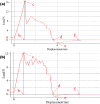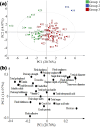Genetic diversity and comprehensive evaluation of physicochemical traits in Phyllanthus emblica L. for breeding and resource utilization
- PMID: 40898031
- PMCID: PMC12403287
- DOI: 10.1186/s12870-025-07161-x
Genetic diversity and comprehensive evaluation of physicochemical traits in Phyllanthus emblica L. for breeding and resource utilization
Abstract
Phyllanthus emblica L. is a nutritionally and medicinally valuable fruit tree with extensive germplasm diversity. This study evaluated 61 genetically diverse accessions collected from China and South Asia for 27 physicochemical traits, including 13 physical and 14 chemical attributes, to assess genetic diversity and identify elite germplasm for breeding. Substantial phenotypic variation was observed, with coefficients of variation (CV) ranging from 5.13 to 98.09% for physical traits and 1.51-59.82% for biochemical traits. Notably, single fruit weight (CV: 98.09%), flesh stickiness (63.65%), crude fat (59.82%), and polysaccharide content (50.12%) exhibited high variability. Fifteen traits conformed to a normal distribution and were categorized into five probability-based grades. Correlation analysis showed that pericarp strength was significantly positively correlated with soluble solids, titratable acid, total flavonoids, polyphenols, and tannin content, while flesh hardness correlated positively with crude fiber and total sugar. Principal component analysis (PCA) reduced the 27 traits to 12 representative indicators, accounting for 82.54% of total variation. Hierarchical clustering grouped the germplasms into three classes: Class I (19 accessions) with high antioxidant contents and strong textures; Class II (2 accessions) with the largest fruit size and high flesh toughness; and Class III (40 accessions) with high moisture content and lower values for most traits, suitable for juice processing. A comprehensive biochemical evaluation model was constructed using PCA-derived weights, and the top-performing accessions-PEF30, PEF41, PEF35, PEF17, and PEF31-demonstrated superior nutritional quality based on total sugar, polyphenols, vitamin C, and flavonoid contents. These accessions are promising candidates for functional food development, fresh consumption, and cultivar improvement. This study provides a robust analytical framework and theoretical foundation for the classification, conservation, and targeted utilization of P. emblica germplasm in breeding programs.
Keywords: Amla; Diversity analysis; Fruit quality; Resource conservation; Tropical and subtropical fruit.
© 2025. The Author(s).
Conflict of interest statement
Declarations. Ethics approval and consent to participate: This study was not a clinical trial and was conducted in accordance with the applicable institutional, national, and international guidelines and regulations. All necessary permissions were obtained for the collection of plant material from P. emblica. Consent for publication: Not applicable. Competing interests: The authors declare no competing interests.
Figures











Similar articles
-
Morphological and Pomological Characterizations of Peach [Prunus persica (L.) Batsch] Accessions.Food Sci Nutr. 2025 Jun 27;13(7):e70501. doi: 10.1002/fsn3.70501. eCollection 2025 Jul. Food Sci Nutr. 2025. PMID: 40585499 Free PMC article.
-
Multivariate assessment of morpho-biochemical and bioactive diversity in Syzygium cumini (L.) Skeels for the selection of superior genotype and breeding applications.BMC Plant Biol. 2025 Jul 26;25(1):962. doi: 10.1186/s12870-025-06977-x. BMC Plant Biol. 2025. PMID: 40713491 Free PMC article.
-
Morphological diversity assessment in date palm (Phoenix dectylifera L.) germplasms grown under hot arid region of India.BMC Plant Biol. 2025 Aug 29;25(1):1159. doi: 10.1186/s12870-025-07194-2. BMC Plant Biol. 2025. PMID: 40883695 Free PMC article.
-
Phyllanthus emblica fruits: a polyphenol-rich fruit with potential benefits for oral management.Food Funct. 2023 Aug 29;14(17):7738-7759. doi: 10.1039/d3fo01671d. Food Funct. 2023. PMID: 37529983
-
Falls prevention interventions for community-dwelling older adults: systematic review and meta-analysis of benefits, harms, and patient values and preferences.Syst Rev. 2024 Nov 26;13(1):289. doi: 10.1186/s13643-024-02681-3. Syst Rev. 2024. PMID: 39593159 Free PMC article.
References
-
- Baliga MS, Dsouza JJ. Amla (Emblica officinalis Gaertn), a wonder berry in the treatment and prevention of cancer. Eur J Cancer Prev. 2011;20:225–39. - PubMed
-
- Qiaoming Li JZ. Genetic diversity of Phyllanthus emblica populations in dry-hot valleys in Yunnan. Biodivers Sci. 2007;15:84–91.
MeSH terms
Grants and funding
- 2022R1028004/public welfare projects of Fujian Provincial Department of Science and Technology
- XTCXGC2021019-GSS01/The Fujian Provincial People's Government and the Chinese Academy of Agricultural Sciences high-quality agricultural development surpassed the "5511" collaborative innovation project
- CXPT2023004/the science and technology innovation platform of Fujian Academy of Agricultural Sciences
LinkOut - more resources
Full Text Sources

